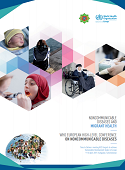Noncommunicable diseases and migrant health (2019)

Download
The 53 countries of the WHO European Region have a population of almost 920 million, representing nearly a seventh of the world’s population; international migrants make up almost 10% (90.7 million) in the Region and account for 35% of the global international migrant population (258 million). The proportion of international migrants, including refugees, in Member States of the Region varies from more than 50% in Andorra and Monaco to less than 2% in Albania, Bosnia and Herzegovina, Poland and Romania. As a consequence, displacement and migration-related programme and policy priorities may vary between Member States. The 2030 Agenda for Sustainable Development recognized the positive economic and development contributions made by refugees and migrants.
However, refugees and migrants can experience negative health consequences during their displacement and migratory trajectories that can have repercussions on their families, their communities and the host population. This short publication includes five policy briefs covering different aspects of refugee and migrant health.



